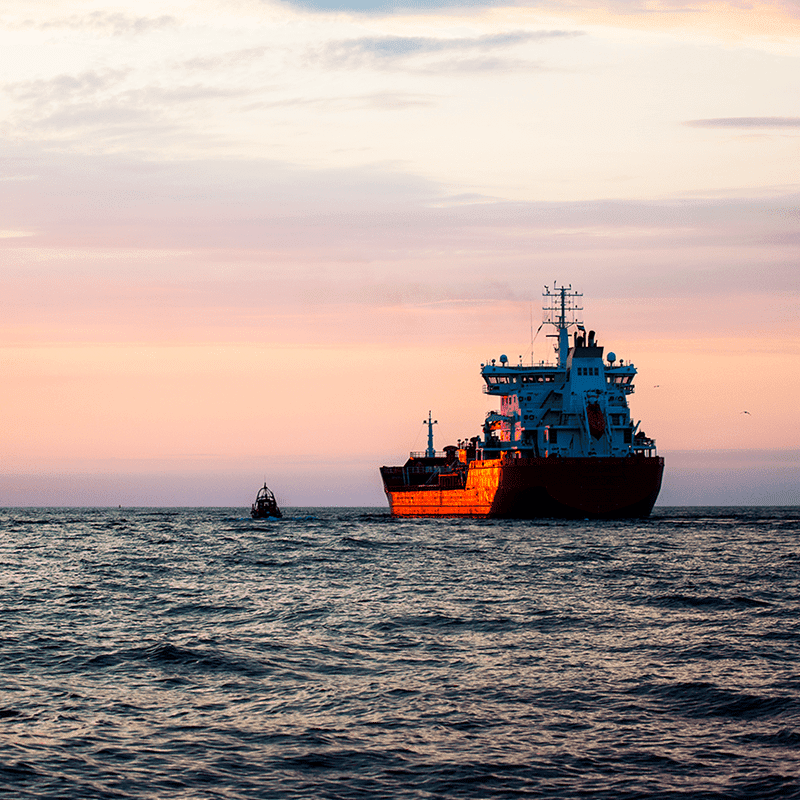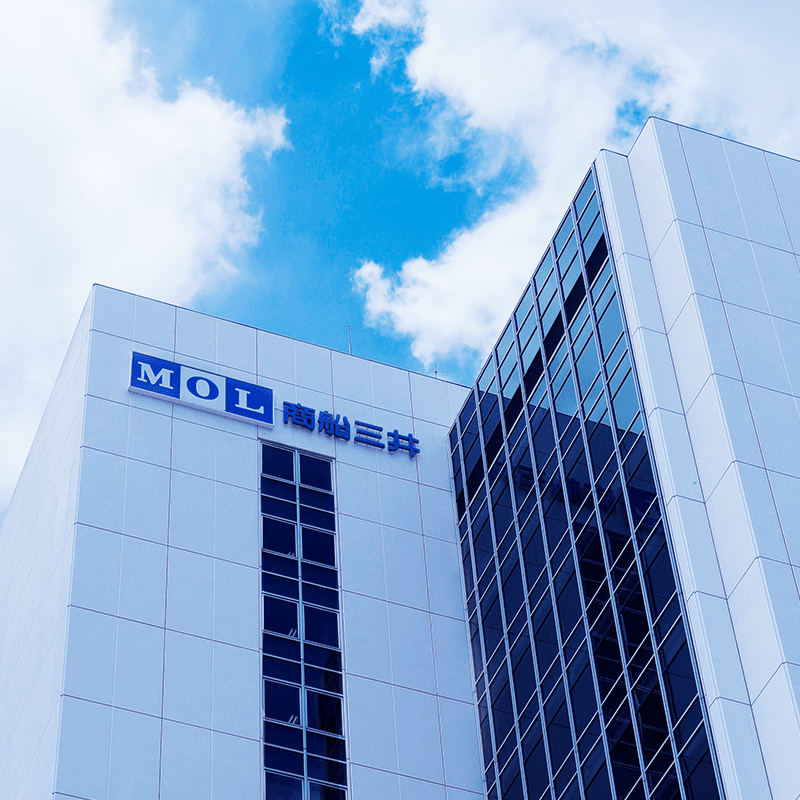BLOG
COP28: Review of MOL's participation
- General Shipping
2024.02.21
COP28 was held in Dubai, UAE, from 30 November to 12 December, 2023, and MOL was the only shipping company to exhibit at the Japan Pavilion hosted by the Ministry of the Environment.
In this blog, we will bring you an overview of the COP and a report from our colleague who traveled to Dubai.
What is COP?
You may have seen news related to COP28, which was attended by various leaders, including Prime Minister Kishida and heads of state from various countries, UN officials, and corporate leaders. But do you know in detail what the purpose of COP is? Let me give an overview and background of COP.
COP stands for "Conference of the Parties", and this is a meeting where countries that have ratified a certain treaty or protocol gather, so there are various "Conference of the Parties" around the world. Among them, the international conference on climate change, which was held this time, is often reported as "COP". COP28 represents the 28th "Conference of the Parties of the UNFCCC (United Nations Framework Convention on Climate Change)". The first one (COP1) was held in Berlin.
COP is held over approximately two weeks, and in addition to meetings at the prime ministerial and ministerial levels, discussions on individual themes are held. Various stakeholders, including governments, scholars, NGOs, and business leaders from various countries, participate in the conference. A variety of events and sessions on diverse themes are held, and the latest information on climate change is exchanged and discussed.
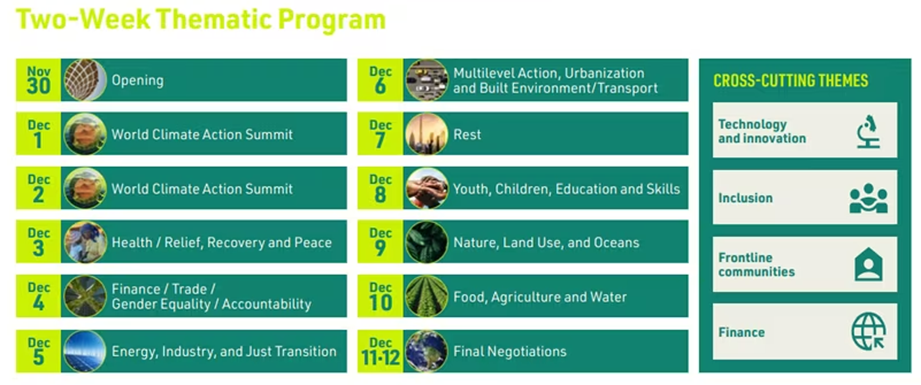
(Daily Agenda for COP28. Discussions on the above topics was held over a two week period.)
COP originated from the adoption of the UNFCCC in 1992, the ultimate goal of which is to stabilize the concentration of greenhouse gases (GHG) in the atmosphere, and a worldwide agreement to make global efforts to institute global warming countermeasures. The resolution of climate change, a borderless issue, requires a global response, and the COP, a forum for multilateral consensus-building, plays a significant role in this.
There are agreements such as the Kyoto Protocol, which set legally binding numerical targets for emission reductions in developed countries and was adopted at COP3, held in Japan, and the Paris Agreement, which was adopted at COP21 held in France. The Paris Agreement, as a new international framework for reducing greenhouse gas emissions after 2020, set a common long-term goal of limiting global warming to 2℃ and pursuing efforts to limit it to 1.5℃.It was highlighted as a turning point in climate change measures.
The overview of COP28 held in Dubai was as follows: it was notable for the first implementation of the Global Stocktake (GST), which comprehensively evaluates the progress of each goal set in the Paris Agreement every five years, and discussions aimed at reducing fossil fuels.
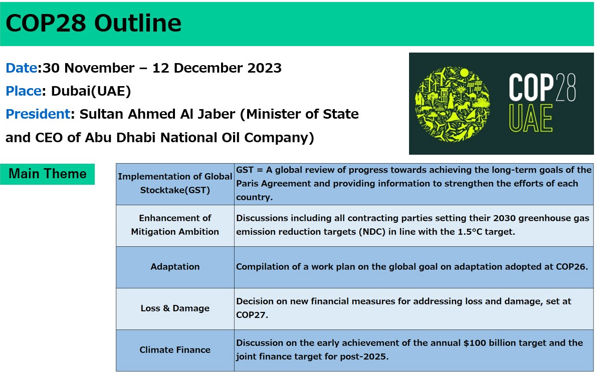 Overview and main themes of COP28 (based on documents from JETRO)
Overview and main themes of COP28 (based on documents from JETRO)
Accelerating the transition from fossil fuels, Tripling renewable energy by 2030
At COP28, an outcome document was adopted that includes accelerating the transition from fossil fuels and expanding renewable energy to three times its current level by 2030. Although the term "abolition" of fossil fuels, which was a focus at this COP, was changed to "transition", it can be said that a significant step has been taken towards realizing a decarbonized society by clearly stating the direction of reducing the use of fossil fuels.
In addition, as a measure to reduce greenhouse gas (GHG) emissions to virtually zero by 2050, the document includes wording that encourages the transition from fossil fuels to renewable energy by setting a specific time limit and accelerating the transition from fossil fuels in the energy system in a fair manner based on scientific knowledge during the 2020s. Furthermore, it is stated that in order to keep the global temperature rise within 1.5 degrees, it is necessary to reduce GHG emissions by 60% compared to 2019 by 2035.
Promoting Wind Utilization in Ships, Wind Challenger and Wind Hunter
The Ministry of the Environment set up the "Japan Pavilion" to showcase Japan's excellent products and services and its efforts against climate change to the world, in conjunction with the hosting of COP28. As part of the exhibits at the pavilion, MOL showcased the next-generation wind-powered vessel “Wind Challenger” and the green hydrogen-producing vessel “Wind Hunter” under the theme of “Using wind power technology on vessels” at the COP28 Japan Pavilion. These are products and services that support the realization of Japan’s long-term goal of “Carbon Neutral by 2050” and the decarbonization and climate change adaptation of the world.
The Wind Challenger is a variable hard sail that can convert wind power, a renewable energy, as a propulsion for vessels, reducing the use of fossil fuels and GHG emissions without changing speed. The Wind Hunter is a green hydrogen-producing vessel, and a next-generation vessel project that not only uses wind power as a propulsion for vessels but also enables the transportation of green hydrogen produced from wind on the vessel to the onshore consumption area. For more details, please check the links above.
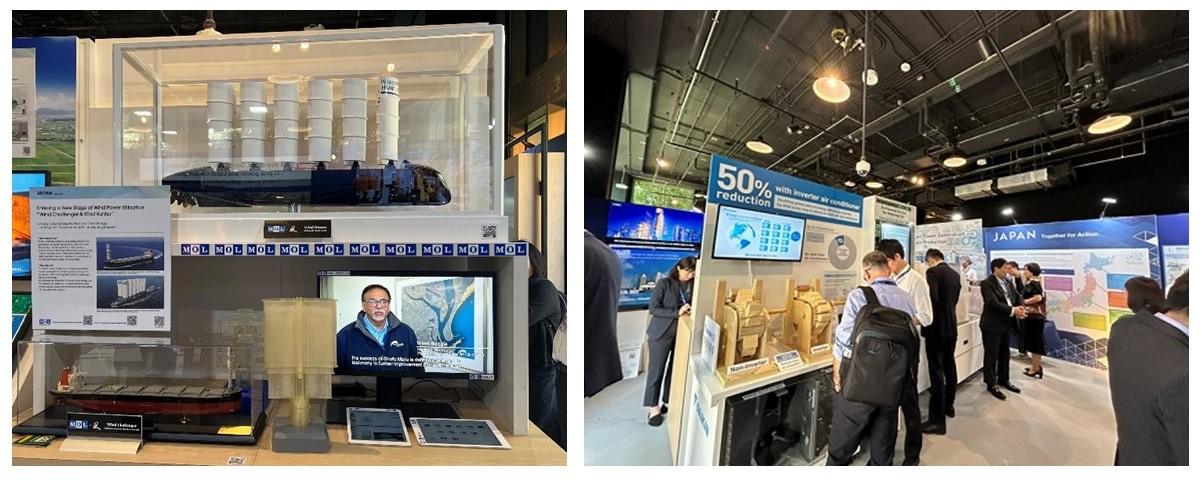
MOL booth (left) and Japan Pavilion (right)
The Japan Pavilion favored a blue overall design, with the left half of the pavilion being an exhibition space. The right half was a seminar space organized by Japanese government officials. (Source: JETRO)
A view of COP venue
COP28 was held at a venue repurposed from the Dubai Expo, the site of the 2020 Dubai World Expo. The venue is divided into two areas: the “Blue Zone,” which is managed by the United Nations, and the “Green Zone,” which is managed by the host government. In the Green Zone, events, exhibitions, and workshops related to climate change are held, and general participation is possible once registered. The Japan Pavilion was located in the Blue Zone area, as are the pavilions of other participating countries.
Participants in COP needed to register at the counter before entering the venue. Given that over 70,000 participants were expected, it was a great success, with it taking over an hour from lining up in the registration queue to completing registration. In addition, free water was distributed as a measure against heatstroke, along with tumblers and free metro passes for the duration of COP for participants.
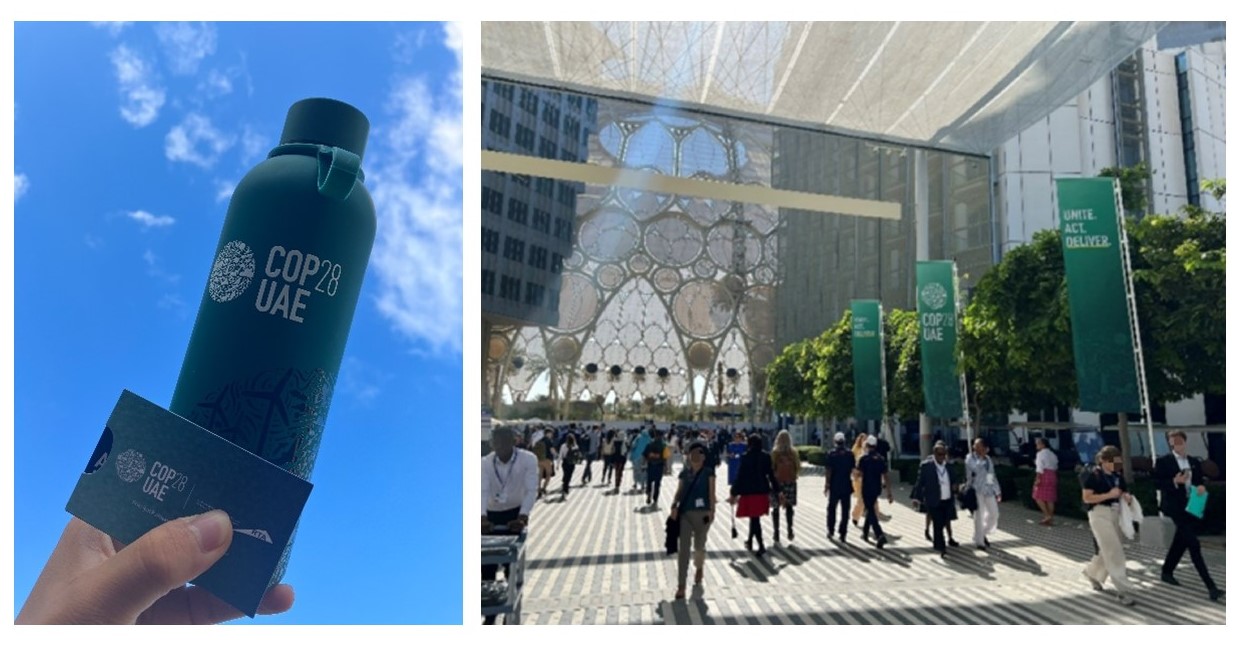
Tumblers and Metropass distributed at the venue (left) and inside the venue (right)
(Photo by the author)
Incidentally, Dubai Expo covers 438 hectares of blue and green zones, which is about 90 times larger than Tokyo Dome (4.7 hectares)! Since it takes a long time to walk around, there were cars and electric scooters on the streets of the venue to transport participants to their respective destinations. I took the opportunity to walk around and visit the exhibits in the Green Zone during my spare time, and when I checked my pedometer upon returning to the hotel, I found that I had walked over 20,000 steps.
In addition to the pavilion exhibits, side events such as panel discussions and workshops on a wide range of themes, including industrial energy transition, decarbonization policies, and renewable energy, were held daily in the Blue Zone. I was able to witness some heated discussions that surpassed even the temperature in Dubai!
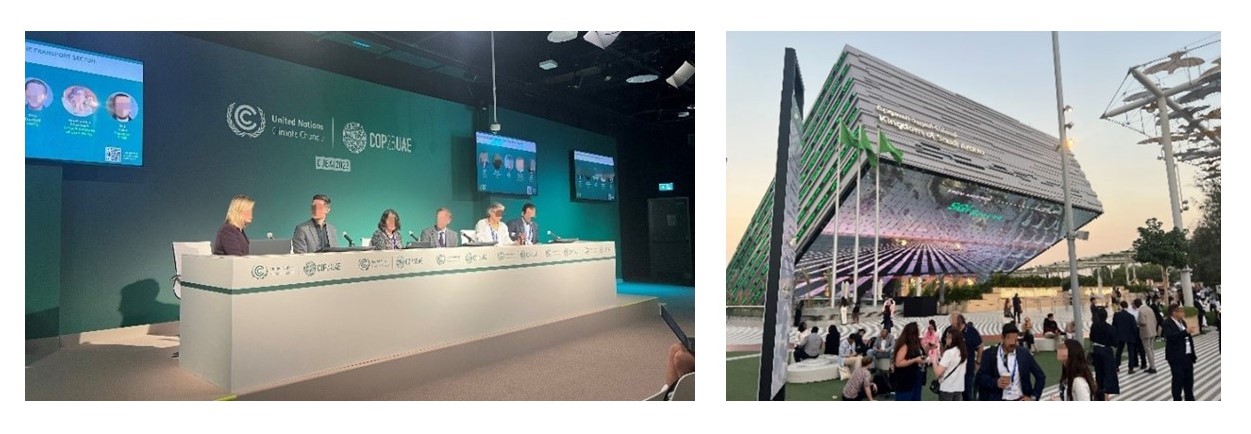
Blue Zone side event, Saudi Green Initiative (right) (Photo by the author)
The Saudi Green Initiative, located in the Green Zone, showcased Saudi Arabia's environmental initiatives and future initiatives. (The building makes an impact!)
To achieve net-zero emission by 2050
At COP28, through our exhibition at the Japan Pavilion, we had the opportunity to introduce our advanced environmental initiatives to visitors from around the world, including companies, public institutions, politicians, students, and others from various backgrounds, even those who usually have no contact with the maritime industry.
We also received a wide range of questions and feedback from many pavilion visitors and various stakeholders, from the structure of the sails and ships to the impact of our services on the environment. We were very pleased to see the great interest in our initiatives through these communications with participants.
As of 2022, the shipping industry accounts for approximately 2% of global CO2 emissions, and like other industries, it is required to reduce CO2 emissions. The International Maritime Organization (IMO) has set a goal to reduce ship CO2 emissions to virtually zero by around 2050, and the trend towards decarbonization in the maritime industry is accelerating.
Therefore, in addition to our traditional maritime transport services, we are actively adopting energy-saving devices and clean alternative fuels leading the way among integrated maritime companies, and we will steadily work towards achieving net-zero emissions by 2050 to contribute to the realization of a decarbonized society and a prosperous future.
We would also like to take this opportunity to thank all those involved in hosting COP28 and the Japan Pavilion.
Click here for more details of MOL initiatives during COP28.

Writer:Akihiro
I majored in environmental economics at the university and graduate school. After graduating, I joined Mitsui O.S.K. Lines and was assigned to the Corporate Marketing Divition. I am responsible for researching macroeconomic information and handling cross-departmental marketing activities across the entire company. On weekends, I enjoy going fishing and watching baseball games to relax.
Recommended Articles
2022.07.05
- General Shipping
2021.04.13
- Energy
2023.12.19
- General Shipping
2021.08.07
- Eco Friendly
2025.03.18
- General Shipping
Latest Articles
2025.12.09
- Eco Friendly
- General Shipping
2025.12.03
- General Shipping
2025.11.20
- Energy
- General Shipping

